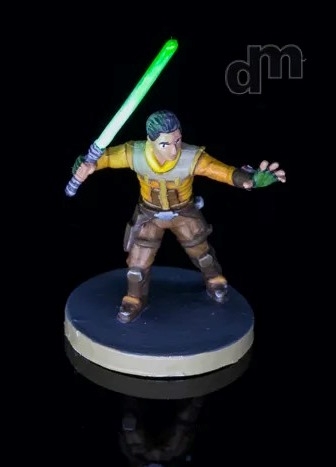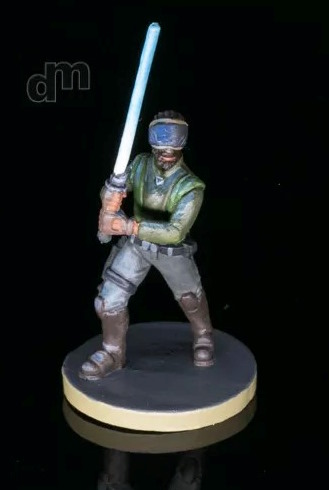Wave 11 Ally Pack – Ezra Bridger and Kanan Jarrus

Ezra Bridger, painted and photographed by Damjan on boardgamegeeks.com
Campaign
Both of the new Jedis of the Rebels TV show come with dedicated Campaign Deployment Cards. Starting with Ezra Bridger, shows how far the game has come. With a Deployment Cost of 7, he is 3 Threat cheaper than Luke Skywalker from the core box. Yet, his statistics are almost comparable. Health of 10, Speed of 4, white defense die and a green-yellow-yellow melee attack. An innate +1 Block, Surge for +2 Damage, Surge for Pierce 3 and Surge for Recover 2 Damage round out his stats. You’d think his Speed of 4 and only having a melee attack makes him significantly worse, but with Brash, he can move 4 additional spaces each start of round. And while Luke lets others reroll attack dice, with Stronger Together Ezra can reroll his attack dice, based upon who of the Rebel Heroes he is near to during the attack. In the campaign, his lower cost certainly is justified, though in the early campaign, he is worth a bit more than Luke. There is no denying, though, that Luke is still preferable in the later stages of a campaign, to benefit from his reroll.

Kanan Jarrus, painted and photographed by Damjan on boardgamegeeks.com
Kanan Jarrus however, is stronger. For only one Deployment Cost more, bumping him to 8, you get 14 Health and a black defense die. With a Speed of 4, a green-green-yellow melee attack and Surges for +2 Damage as well as Pierce 3 his statistics alone are a good reason to bring him. Force Vision straddles the line a bit. It is cool to “predict the future” for the Imperial Player, but since it’s at the start of Kanan’s activation, instead of the start of the round, its impact is often limited. You really bring him for Soresu Defense. Similar to Luke, he offers a reroll, this time it’s on a defensive roll instead. Its drawbacks are also subtle enough not to interfere with its usefulness. Is he better than Ezra in the campaign? Late in the campaign, his star rises considerably above Ezra’s, but otherwise it is kind of a tossup.
Earning both for the campaign works a bit different for them. The included Side Mission Executive Overreach rewards 1 Spectre Ally of the Rebel Player’s choice, instead of granting you access to just Ezra and Kanan directly! Remember that this technically also includes Hera and, Chopper from their Ally Pack, as well as Sabine and Zeb from their Ally Pack.
To recruit any Spectre Ally for your campaign, you need to win the side mission Executive Overreach included in this pack. This mission requires map tiles from the Tyrants of Lothal expansion!
Skirmish
As Anakin once said: This is where the fun begins. Both Ezra’s and Kanan’s Skirmish Deployment Cards have identical stats to their Campaign Deployment Cards. Only their non-Surge abilities are different. Brash on Ezra’s card is actually identical, letting him move up to 4 spaces at the start of a round. This is much more valuable here, as positioning with a melee figure is one of the key skills to master in Skirmish. Brash just makes that much easier. The real meat for Ezra is in Much to Learn, though. Like in the campaign, it gives him a reroll if someone is near him. If that someone has the Force User trait, Ezra’s player can even choose the side of the die they want! This makes his output and also his Recover 2 much more consistent, as you can guarantee damages and surges on unlucky rolls. Kanan’s Force Vision is adapted to Skirmish, and has the opponent choose which of their Deployment Groups they activate next. Soresu Defense is as good as it is in the campaign, just that it actively references the Force User trait instead of a melee attack type.
All of this is decent, but not really great. The included Skirmish Upgrade Card Doubt doesn’t tip the scales either. For 1 Deployment Point, it just does not offer enough. The magic happens in the Tyrants of Lothal expansion. With the Skirmish Upgrade Card Spectre Cell Kanan and Ezra instantly gain permanent +1 Block and +1 Damage. This takes Ezra to +2 Block plus what he rolls on a white die! Also, you gain one extra attack per round with this card. The only drawback is, that you need to run all figures that have the Spectre trait, of course. The full list then is:
- Kanan Jarrus for 8 Deployment Points
- Ezra Bridger for 7 Deployment Points
- Hera Syndulla for 4 Deployment Points
- C1-10P for 3 Deployment Points
- Sabine Wren for 7 Deployment Points
- Zeb Orellios for 8 Deployment Points
- Spectre Cell for 2 Deployment Points
This still leaves you 1 Deployment Point to include Balance of the Force or Unshakable and of course Heroic Effort to make this list shine. This list goes hard. It’s mobile, sturdy, can dish out damage, has a good spread of traits and reliable access to bonus movement and bonus attacks. It really does it all. Remembering all effects on all 6 very unique figures can take a while to learn, but it’s very rewarding.
The party doesn’t stop there. All included Command Cards not only help this list, but some other lists as well. Firstly, their respective signature Command Cards Learn by Example and Protect the Old Ways are both valuable to include, though Ezra’s is generally much more useful. Dying Lunge is a must include for every heavy hitting melee character. You can’t even argue about that. If you have 2 or more unique figures that are melee attackers, take this card. It is that good. Hour of Need is cheap but mostly inconsequential. In a Spectre Cell list, you might have one of your figures survive another attack, as most games do not go over round 3 or 4. But typically you try to increase your damage output and this card just doesn’t contribute to that. Second Chance is more expensive, with 2 Command Points, but it is also more useful. You openly signal which figure you want to shield, often times making your enemy reconsider. However, you still get a Recover 2 at the end of the round. So playing it on a wounded figure is never wasteful.
Models
Both model’s poses are excellent and really reflect the style of the characters. Since lightsabers are never easy to paint, they can be a bit intimidating for new painters.